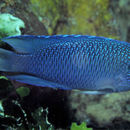Diagnostic Description
provided by Fishbase
Description: Recognized by the brilliant light-blue color (Ref. 48636). This species exhibits a marked sexual dichromatism: juveniles and females usually have a small black spot at the rear base of the dorsal fin and (at least in Micronesia) lack yellow; males have a bright yellow snout and tail and sometimes, latter all orange in some regions; also lack the black spot (Ref. 7247). Body depth 2.2-2.4 in SL (Ref. 90102).
Diseases and Parasites
provided by Fishbase
Livoneca Infestation. Parasitic infestations (protozoa, worms, etc.)
Life Cycle
provided by Fishbase
Oviparous, distinct pairing during breeding (Ref. 205). Eggs are demersal and adhere to the substrate (Ref. 205). Males guard and aerate the eggs (Ref. 205).
Morphology
provided by Fishbase
Dorsal spines (total): 13; Dorsal soft rays (total): 12 - 13; Analspines: 2; Analsoft rays: 13 - 14
Trophic Strategy
provided by Fishbase
Found amongst rubble and coral of clear sheltered lagoons and reef flats (Ref. 9710). Occurs in groups of a male and several females or juveniles (Ref. 1602). The habitat consists of lagoons and protected inshore reefs in knee-depth shallows down to about 10 m (Ref. 54301). Feeds on plants and invertebrates (Ref. 6110). Diurnal species (Ref. 113699).
Biology
provided by Fishbase
Adults are found amongst rubble and coral of clear sheltered lagoons and subtidal reef flats (Ref. 9710, 48636). They occur in groups of a male and several females or juveniles (Ref. 1602). Feed on algae, pelagic tunicates and copepods. Oviparous, distinct pairing during breeding (Ref. 205). Eggs are demersal and adhere to the substrate (Ref. 205). Males guard and aerate the eggs (Ref. 205). Diurnal species (Ref. 113699).
- Recorder
- Estelita Emily Capuli
Importance
provided by Fishbase
aquarium: commercial
- Recorder
- Estelita Emily Capuli

